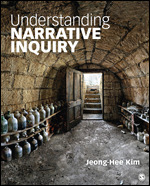Understanding Narrative Inquiry
The Crafting and Analysis of Stories as Research
- Jeong-Hee Kim - Texas Tech University, USA
This comprehensive, thought-provoking introduction to narrative inquiry in the social and human sciences guides readers through the entire narrative inquiry process—from locating narrative inquiry in the interdisciplinary context, through the philosophical and theoretical underpinnings, to narrative research design, data collection (excavating stories), data analysis and interpretation, and theorizing narrative meaning. Six extracts from exemplary studies, together with questions for discussion, are provided to show how to put theory into practice. Rich in stories from the author's own research endeavors and incorporating chapter-opening vignettes that illustrate a graduate student's research dilemma, the book not only accompanies readers through the complex process of narrative inquiry with ample examples, but also helps raise their consciousness about what it means to be a qualitative researcher and a narrative inquirer in particular.
This book has received the 2017 Outstanding Publication Award from the Narrative Research Special Interest Group (SIG) of the American Educational Research Association (AERA). The award honors research-based texts dedicated to advancing the educational process through research or scholarly inquiry.
This is a thorough and inclusive book that can serve as an excellent introduction to narrative forms of qualitative research in the fields of education, medicine, psychology, and legal studies. But Understanding Narrative Inquiry may also serve to extend the knowledge of researchers and practitioners in those fields who are already familiar with this rapidly maturing inquiry approach. Extremely well researched and referenced, it deftly addresses sophisticated theoretical and philosophical underpinnings of narrative research, including the rationales and justifications for engaging in both storytelling and the analysis of stories. And it also explores a wide variety of helpful strategies for interviewing, fieldwork, and writing. But just as importantly, it grounds and humanizes its sophisticated scholarship through an inviting, conversational style replete with personal anecdotes, while its many concrete examples of research practice in action further enhances its usefulness. A remarkable achievement.
This is an outstanding text on narrative inquiry. Kim offers the historical and philosophical context for narrative research, ample methodological instruction, and robust examples, making this a truly comprehensive text. I am particularly impressed with her attention to the different genres of narrative including arts-based and visual-based. This is a must-read for anyone interested in narrative research.
Jeong-Hee Kim masterfully positions readers to enter the storied fabric of human life through the medium of narrative inquiry. Readers across all disciplines and interests will find themselves locating and articulating the textured significances of stories as research. Philosophical/theoretical connections substantively frame and permeate the text with readers importantly gaining context, language, and capacities to design and undertake fitting narrative inquiries. The concrete examples depicting a cross section of genres and the inclusion of a glossary make this comprehensive text an invaluable resource for all interested in crafting and analysis of research through narrative inquiry.
This text offers novice and practicing scholars of narrative inquiry provocative philosophical and methodological insights. The text is beautifully written and draws on art, music, religion, philosophy, and literature to inform researchers’ understandings.
The author’s use of a conversational tone—as if she is talking directly to her students—while guiding the reader through complex theoretical material is noteworthy, as are the expertly designed “Questions for Reflection” and the “Activities” sections at the end of each chapter. This text will be of interest to anyone teaching Qualitative Research Methods looking for ways to engage their graduate students.
Committee selected a different text

 Sage College Publishing
Sage College Publishing

